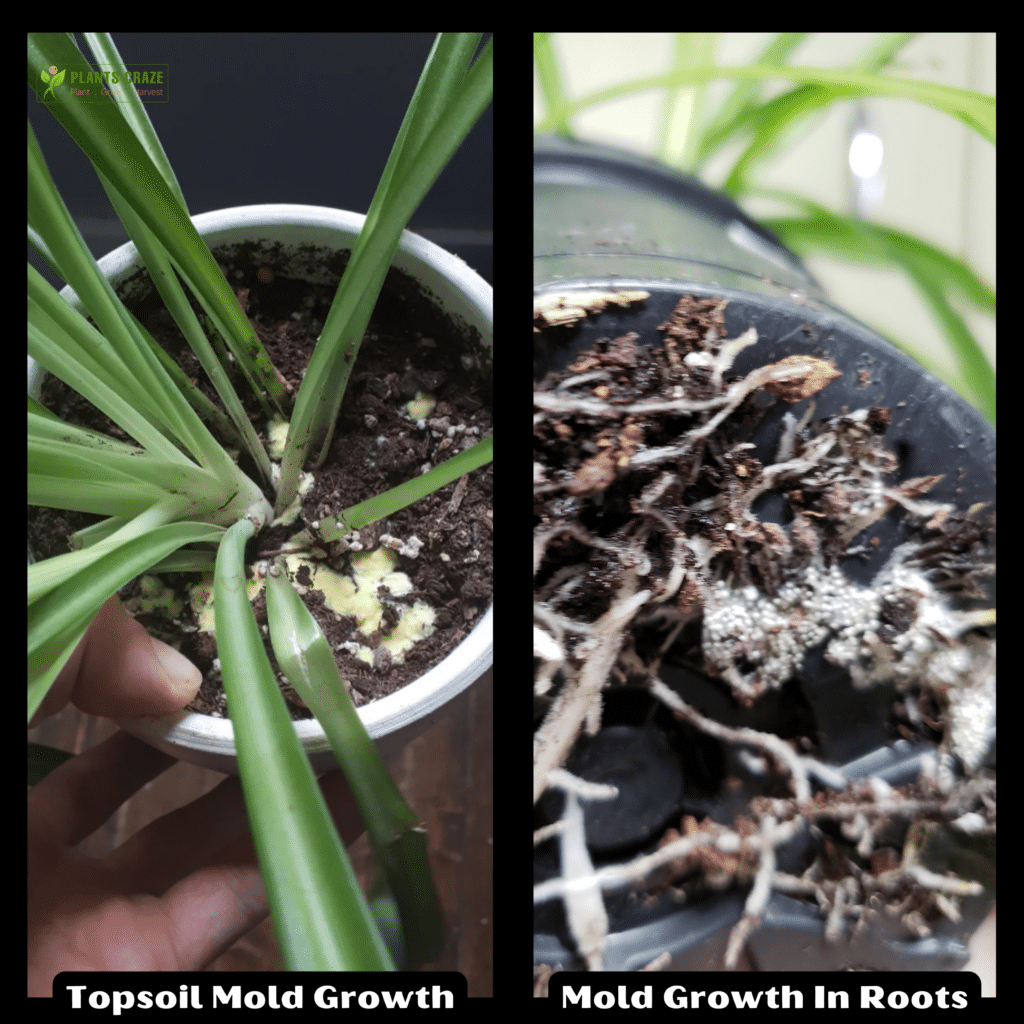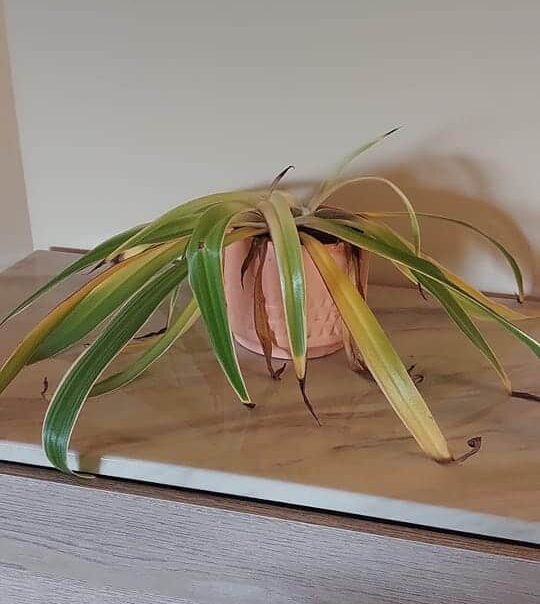Spider Plant is a useful indoor houseplant that can absorb suspending mold spores from the humid indoor air!
However, these moldy spores manifesting from different sources can pose a problem to your plant.
But do you know the best way to detect mold attacks is to check for fungus gnats on the potting soil? Learn more!
Table of Contents Show
Confirming A Moldy Spider Plant [Spider Plant Molds]
Occasionally thick and hairy masses of fuzzy, powdery, or cottony and slimy substances with pale colorings may accumulate in the potting soil of Spider Plants.
They are called molds (similar to white fungus on Spider Plants) and spread profusely to the topsoil layer near the plant’s base.
These moldy growths are mycelial threads of fungi (Rhizoctonia species, Sclerotinia species, Fusarium species, Alternaria species, and Trichoderma species) responsible for causing root rots.

Additionally, the white fuzzy molds on the topsoil of your Spider Plant can be dangerous, as they can circulate to fresh aerial parts from the base.
Since these molds are fungi, they originate from spores.
Further, these dormant spores are already in the soil, awaiting feasible nutrient availability, temperature (77-86°F), and humidity (80-85%) cues for germination to form mycelium threads.
So, fresh potting soil can harbor hidden fungal spores, but they may go overlooked.
Hence, to confirm the presence of molds on your Spider Plant soil, you can inspect for the following signs.
- Formation of a musty or fishy odor from the potting soil
- Cottony gray, white, yellow, or brown growth on the topsoil surface
- Protrusion of similar cottony growth from the drainage holes
- The appearance of fungus gnat larvae inside the soil or adults hovering above the soil
Why Is My Spider Plant Soil Moldy?
The main reasons for Spider Plant molds in soil include the conducive temperature and humidity for fungal spore germination.
However, these conditions may arise from the following reasons, which can easily be deterred with a few precautions.
1. High Soil Moisture
Excessively moist soil creates a suitable domain for the proliferation of soil molds in Spider Plants.
All soil molds need water to activate special enzymes that help them attach to the substrate and break down their food.
How to Fix?
- Water your Spider Plant weekly during spring and summer.
- Check for topical soil moisture (1-2 inches deep) before irrigating in fall and winter.
- Clear the drainage holes every week to seep out the extra water.
- Amend the potting soil with organic perlite to facilitate drainage.
- Switch the potting soil with a fresh one if you smell a fishy odor.
- Sustain the humidity range of around 40-60%.
- Repot your Spider Plant if the soil becomes dirty every 1-2 years.

2. Excessive Fertilizer Use
Frequent organic fertilizer application can cause the Spider Plant soil to develop thick moldy layers.
Organic fertilizers boost soil acidity (lowering the soil pH) due to the decomposition of organic matter, as molds get plenty of free food.
How to Fix?
- Feed your plant monthly doses of liquid fertilizer during spring and summer.
- Avoid fertilizer application in fall and winter.
- Keep the soil pH around 6-6.5 using calcium carbonate powder.
3. Extreme Temperature
An elevated temperature than the normal range is responsible for the growth of molds in Spider Plant soil.
This is because favorable temperature activates certain enzymes, causing the germination of fungal spores.
How to Fix?
- Mist your Spider Plant leaves weekly during summer.
- Keep the surrounding temperature between 65°F and 75°F.
- Use humidity trays to cool down your Spider Plants.
Spider Mites Vs. Fungus Gnats
Pests like spider mites can also attack your Spider Plants and build mold-like webbings.
However, these webbings are not true soil molds. So, spider mites pose a problem by creating unwanted webs on the plant parts.
Unlike fungus gnats, spider mites love dry soil conditions and rarely build webs on the wet soil surface.
Although their thick webby masses may appear like moldy growth, they are unrelated to hovering fungus gnats.
Do You Know?
Hovering pests like fungus gnats prefer the moist soil surface of your Spider Plants as they offer the best flourishing conditions for their brooding larvae.
These gnat larvae are more potent than adults feeding on the molds present on the surface of your Spider Plant soil while also damaging the roots.
Additionally, spider mites create dark brown spots on the Spider Plant leaves by blocking entire surfaces.

But Spider Plant molds are the favorite food of gnat larvae. So, if you witness gnat larvae on the surface of Spider Plant soil, you are free to confirm a mold invasion.
How To Get Rid of Fungus Gnats and Spider Mites?
To eliminate mites and gnats in your Spider Plants, follow these steps below.
- Clean the webbing off the plant leaves and stems using a cotton ball soaked with diluted neem oil.
- Use a strong blast of tap water to skim off the adult mites from the plant leaves and stems.
- Place sticky traps around your Spider Plants to capture the adult fungus gnats.
- Maintain alternate moist and dry soil conditions to deter spider mites while preventing fungus gnat infestation.
- Prevent watering during fall and winter or keep the potting soil of Spider Plant dry between watering sessions.
- Always use clean soil while repotting your Spider Plant.
From Editorial Team
Additional Solutions!
The case of Spider Plant mold becomes problematic due to overwatering conditions synced with conducive temperature and humidity.
These conditions can increase the odds of the germination of mold spores.
However, you can kill the mold spores by steaming the soil for 30 minutes at 145°F before using it.
